by Adreon Hubbard
On my walks through the neighborhood, I’ve noticed street and yard trees with various issues that might have been prevented through correct pruning. Our trees are subjected to many stressors beyond our control, but pruning when a tree is young is something the average person can do (even an arthritic retiree such as myself) to help the tree withstand these threats and live a longer, healthier life. Pruning also provides a fun outdoor workout and sense of accomplishment. Having just completed my TreeKeeper Pruning Certification, I am excited to share some tips and tricks. Even if you prefer to hire someone to prune your trees, knowing the basics can help ensure that you hire a competent professional and not a “hacker.”
Know when to prune, and keep safety in mind. The best time of year to prune most trees is generally thought to be in the dormant season, especially late Winter through early Spring. Pruning just before the flush of new growth allows trees to seal off their wounds rapidly. You can also see the branch structure clearly before leaf out, and there are fewer pests and diseases waiting to attack the wounds. Elms and oaks should only be pruned through February, however, due to their susceptibility to Dutch Elm and Oak Wilt Disease. Avoid pruning after severe drought. With that said, most trees can be safely given a light pruning at any time of year.
Wait two-three years after planting your tree before pruning it to allow for proper root establishment, but don’t wait until the tree is so large you can’t reach the branches with a pole pruner while standing on the ground. Tree climbing, ladders, power tools, and removing branches larger than 4” in diameter or close to power lines are best left to the professionals!
Know your reason for pruning. The interrelated goals of human safety, tree health, and aesthetics are the main reasons for pruning. Weak branch connections caused by poor structure may cause branches to break off in storms, leaving a jagged tear which opens the tree up to disease and decay. Healthy tree structure reduces such risks and tends to look balanced and attractive. Before pruning, spend some time carefully observing the tree from different angles. Ideally, do this with a friend to have a second set of eyes on it. You cannot put back a branch once it is cut, so “less is more.” Pruning is recommended in order to:
- Remove a second trunk or branch competing with the dominant trunk (certain species, such as SweetBay Magnolias, can be allowed to have multiple trunks)
- Remove dead branches or stubs
- Remove or shorten crossing, rubbing branches
- Remove or shorten nuisance branches in the street or sidewalk
- Remove branches with a V-shaped union (weak attachment)
- Thin the crown to increase light penetration and air flow
- Remove basal sprouts (“suckers”) or water sprouts
Know where to make the cut. Every cut causes a wound to the tree that never completely heals. Instead, the tree seals off, or compartmentalizes, the wound by making a callus around it. Arborists call this C.O.D.I.T.: Compartmentalization of Decay In Trees. Incorrect cuts lead to poor wound closure, leading to decay and infection. Look for the swollen part of the branch or trunk where the branch is coming out. That swollen area is called the branch collar and contains special cells that seal off the wound effectively. Always cut just beyond the branch collar in order to leave the branch collar on the tree. Use sharp, by-pass hand pruners, a pruning saw, or pole pruners for the cleanest cut. A clean cut will heal faster than a jagged cut, just like our skin heals faster from a paper cut than a gash. Use the 3-cut method for larger branches to reduce the risk of bark tear (see diagram.)
Don’t be a hacker: pruning practices that harm trees:
- Flush cuts: do not cut the branch flush with the trunk or parent branch–doing so will remove the branch collar and make the wound fail to close or close more slowly, leading to infection and decay.
- Stubbing: try not to leave a stub of the branch you are cutting. Be careful to cut just outside of the branch collar, but not too far outside of it. This can be tricky and take some practice.
- Tipping: do not cut at a random spot on the branch just to shorten it. Branches should be cut just after a lateral branch one-third its size. Tipping causes the whole branch to die back and decay.
- Limbing up: do not cut the lower branches of the tree higher than one-third of the way up the trunk. It is especially important for young trees to retain their lower branches, because they help the tree trunk grow thicker and stronger.
- Topping/crown reduction: do not chop off the ends of the branches of a medium-large tree to reduce its size. This causes the tree to send up multiple water sprouts with weak branch connections in a frantic effort to produce leaves to feed the tree. It also creates large wounds that the tree is not able to seal off. Topping is an outdated, poor pruning technique no longer practiced by reputable arborists.
- Over pruning: do not remove more than 25% of the tree’s branches. Additional pruning can be done when the tree is older.
Next Steps: Feeling overwhelmed? I would be happy to visit your yard to give you tips (please email me at hubbardesol@gmail.com), and a neighborhood volunteer tree pruning demo and event is in the works for next winter. If you would like to learn more about tree pruning and planting and become part of a community of wonderful “treeple” who love trees, please consider taking the excellent TreeKeepers class run by TreeBaltimore of Baltimore City Rec & Parks. https://www.treebaltimore.org/treekeepers. It is free, open to county residents, and offered every Spring and Fall. Don’t have time for a class? The USDA Forest Service PDF HOW to Prune Trees is an excellent resource:, and there are helpful videos online, such as Ask an Arborist: The ABC’s of Pruning and 3 Step Pruning for Deciduous Trees. Thank you for caring for our community’s precious trees!
Sources:
Gilman, Edward: An Illustrated Guide to Pruning, 3rd Edition https://wwv.isa-arbor.com/store/product/24/
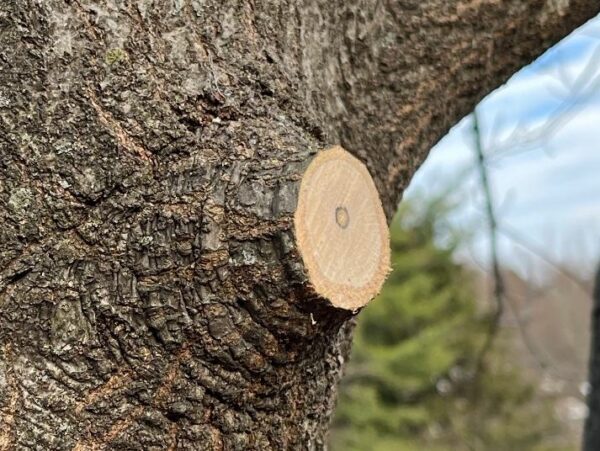
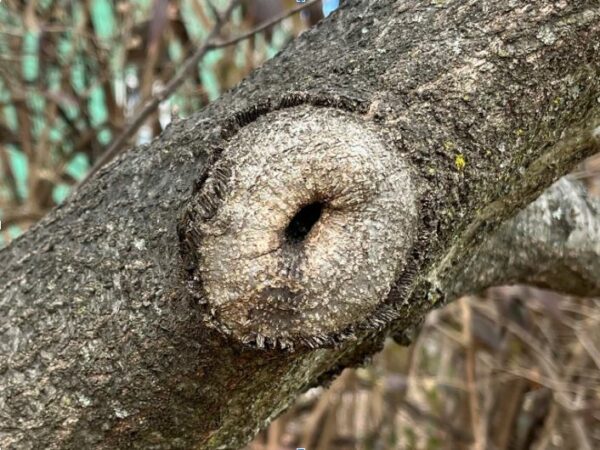
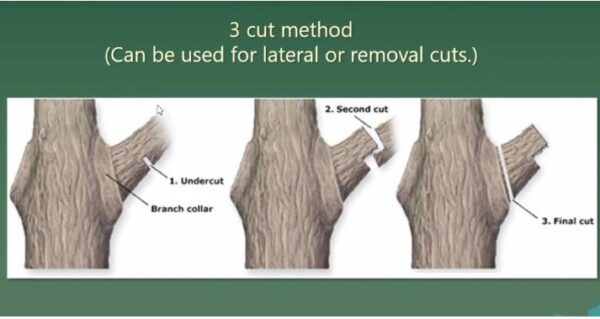
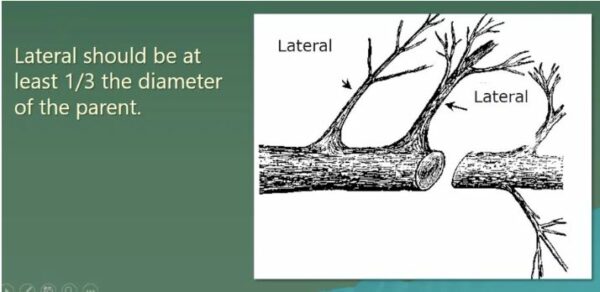



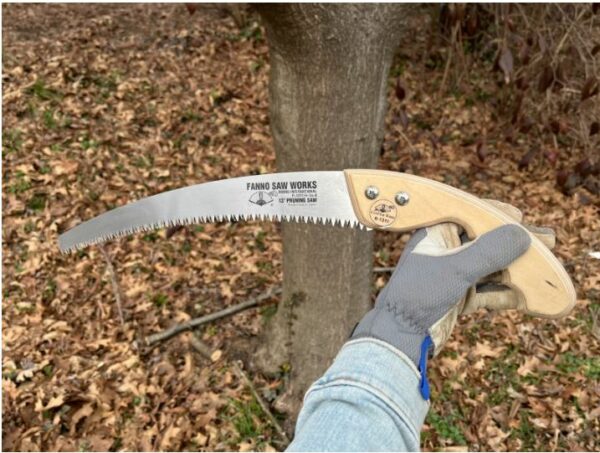

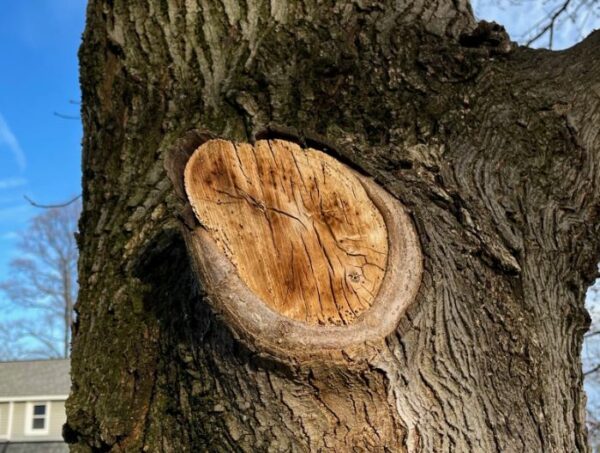
Adreon Hubbard is a certified Baltimore Weed Warrior and TreeKeeper, and a Maryland Master Naturalist and Master Gardener. She took all of the photos used in this article. The first two diagrams above are from a training PowerPoint from an online TreeKeeper class. The third diagram is from the USDA How to Prune PDF referenced in the article. This article originally appeared in the March 2023 issue of the Idlewylde Community newsletter, Idlewylde News. Adreon writes a regular nature column called In the Wylde.
